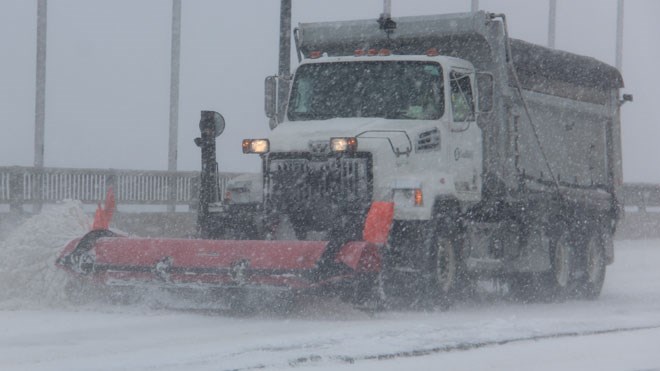Those seeking alternatives to sodium chloride (road salt) for de-icing roads and parking lots are likely to be disappointed in a new city report.
Following a list of possible alternatives, a report by city engineering services director David Shelsted notes, “there are no cost-effective alternatives to salt,” with the vast majority at least 10 times more expensive than what the city already uses.
It’s also unclear what the potential long-term impacts of many of the chemicals might be, while other options also contain chlorides or nitrogen, “and are also environmentally problematic.”
The report is on the agenda for the Sept. 13 city council meeting. It was drafted at the request of city council to investigate ways of limiting the use of road salt at the Kingsway Entertainment District property, a now-cancelled municipal hockey arena/events centre planned for construction on The Kingsway.
Also to be accompanied by a private hotel, casino and shared outdoor space, the centre would have included a ring road encircling it, 1,250 parking spaces plus an additional 1,400 spaces dedicated to overflow parking.
While the implications of part of the road salt report might carry less relevance now that the KED is dead, it’s an issue that comes up regularly due to ongoing environmental concerns in relation to the watershed. Mayoral candidate Miranda Rocca-Circelli has included tackling road salt used for dust management in her agenda.
Further, although the city is currently winding down their involvement in the KED, Ward 5 Coun. Robert Kirwan, a longtime proponent for the project, has clarified the project as a whole isn’t necessarily dead.
“Let's not forget that our decision does not prevent the casino and hotel, or any other interested business from developing as part of the Kingsway Entertainment District,” he said. “It just means that the city will no longer be taking part.”
De-icing salt, according to Shelsted’s report, is used extensively in Canada “because it is effective, relatively easy to transport and use and low in cost.”
A five-year scientific assessment under the Canadian Environmental Protection Act concluded “that de-icing salt is entering the environment in quantities that may pose immediate or long-term environmental risk,” with elevated concentrations of chloride salts having the potential to cause “adverse effects on aquatic species, terrestrial vegetation, wildlife mortality and soil chemistry.”
A Code of Practice for the Environmental Management of Road Salts applies to organizations that use more than 500 tonnes of road salts per year and have vulnerable areas in their territory, which applies to the City of Greater Sudbury.
Most private sites fall below the 500-tonne threshold, meaning commercial operators for clearing snow and ice from parking lots “have the potential to use larger amounts of salt, in part because the commercial operators are often compensated on the basis of use.”
In the event the city were to have proceeded with the KED, the plan was to maintain the parking lot and sidewalks at a snow packed level, which would have been accomplished through plowing and sanding. The city’s winter sand mixture includes five per cent salt to prevent the freezing of material.
The city had proposed to use an alternative product around the main entrance, though it carried a liability concern in the event of a slip and fall incident.
With the city backing out of the KED and the property slated to transfer back to the developer effective July 31, 2023, at the latest, the city’s more-robust Salt Management Plan will no longer apply to whatever is constructed on site.
Approximately 40 per cent of the salt used in urban areas is placed on parking lots and sidewalks at commercial, industrial and institutional areas, according to Shelsted’s report.
The ring road around the KED site would have been classified as a class one to two road and be maintained to bare pavement, which includes the application of road salt.
The following are the alternatives to sodium chloride included in Shelsted’s report:
- Calcium chloride: The second-most common deicing chemical to salt. It’s more corrosive to metal than sodium chloride, carries environmental impacts due to chlorides, can contribute to slippery conditions if applied incorrectly and is approximately 10 times more expensive than sodium chloride.
- Potassium chloride: Can be damaging to concrete, has environmental impact due to chlorides, can inhibit plant growth and burn foliage, is only effective to -4 C and is approximately 10 times more expensive than sodium chloride.
- Magnesium chloride: Has environmental impacts due to chlorides, must be placed at twice the rate of calcium chloride, can contribute to slippery conditions if applied incorrectly and is more expensive than calcium chloride.
- Urea: Primarily used as a fertilizer and releases nitrogen into the soil and can lead to a chemical imbalance in water systems due to nutrient loading, is only effective to -4 C, is corrosive and breaks down rapidly and is approximately 10 times more expensive than sodium chloride.
- Potassium acetate: Is non-corrosive and used in the airline industry, is effective at -26 C, is biodegradable, can contribute to slippery conditions if applied incorrectly, can lower oxygen levels in the waterbody and is more expensive than calcium chloride.
- Calcium magnesium acetate: Is less damaging to soils and vegetation less corrosive to steel and concrete, is effective at -6 C, does not melt ice and snow but turns it into an oatmeal texture, used to prevent the bonding of ice and snow to the pavement at the outset of a storm and is more expensive than calcium chloride.
- Agricultural byproducts (organic compounds/sugar): Products derived from sources such as corn, beet, grain, alcohol or molasses, slow down the formation of ice crystals and are more expensive than sodium chloride, but dependent on the location of the source material.
Tyler Clarke covers city hall and political affairs for Sudbury.com.
